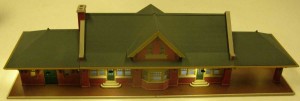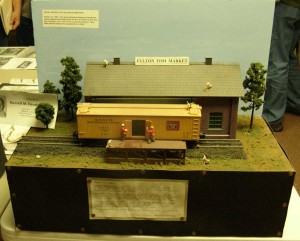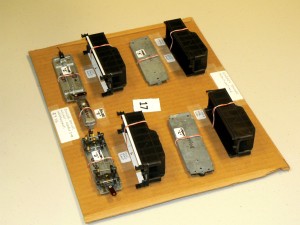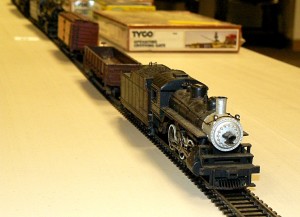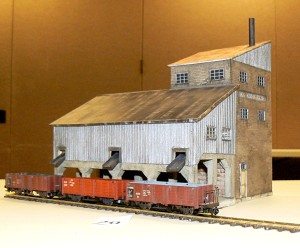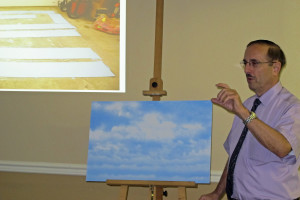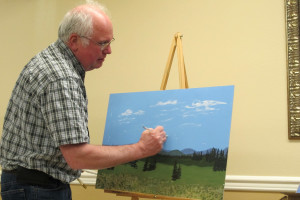Holy Tension and Compression, Batman!
Story and Photos by Jim Sabol

Newcomers Fred and Norma Jean Renspies seem glad they came. We hope they come again.
Our host, Scott “2012 4D Golden Grab Iron Service Award Winner” Buckley, welcomed twenty eager modelers and friends to his Tehama Valley RR layout room for May’s get together—in daylight yet! Scott greeted six first-timers including Ron Brown, Mark Clemons, Dean Cody, John Guydish, and the Renspies: Fred and Norma Jean. It was nice to see globe-trotting Jim “nothing small about N scale” Younkins back safely from his trip down under.
Much discussed was the group’s recent field trip on Amtrak to the Columbia Gorge Model Railroad Club for a day of guest operating on the giant Portland HO layout. Ron “call me coordinator” Bartels did a first rate job of organizing the trip and Jim “Lights! Camera! Action!” Elder shot some great video of trains on the layout
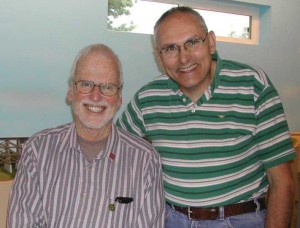
Ted Eggleston and Robert Grove look pleased at being able to find the right PowerPoint buttons.
Clinicians Ted “swipe your martini” Eggleston and Robert “why not model Wyoming?” Grove presented a well-organized and visually arresting program on the nature and location of prominent railroad bridges in the state of Washington. Ted and Robert educated us painlessly on the wide variety and engineering skill evident in our state’s massive railroad bridges—wood, steel, concrete—on both sides of the Cascades.
Jim “hardly ever anything to say” Sabol reviewed the plan for next month’s G.O.P.H.E.R. (Greater Olympia Prototype History & Engineering Research Society) 7th annual outing on June 22 at the Ballard Locks. Manager Byron Cole should have his Ballard Terminal Railroad ex-Milwaukee EMD SW-1 running for us. Members of other 4D clinics are welcome to attend and get a free hot dog lunch by emailing me.
Once again it was discovered that everyone in attendance held a winning door prize number and carried home some form of loot, from HO cars, to switch machines, to great calendar pictures. “It’s a muracle!” exclaimed an amazed Jerry “I hope I win something good” Barnes.
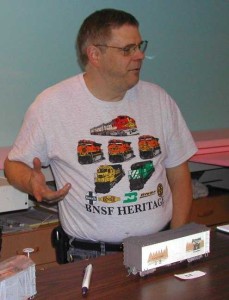
Greg Wright conducts a mini-clinic on car weathering.
Greg “making it a habit” Wright won most popular model with his 1:32n20″ scale boxcar. This month’s Narrow Gauge Gazette features part one of a series of articles on Greg’s layout open house.
Bonus Report
Here is Greg’s mini-clinic on how he created this nifty little car for his Consolidated Republic Mining Co Railroad:
I built this box car from a Boulder Valley Models On30 kit. I altered the underframe to get the couplers to the correct height and modified the roof to produce a taller car. Otherwise, it was built per the directions.
Boulder Valley Models supplies great painting instructions for replicating metal cars with their kits and on their web site. The car was first painted a rust brown color, then bright silver from a spray can was sprayed at arm’s length to splatter silver spots on the brown. It looks awful but it’s not done yet. Splotch on some rubber cement and let that dry. Then wet one side at a time with water (or saliva, per the BoulderValley instructions) and, using a salt grinder, let the ground salt fall on the wet car side. It will stick when the moisture dries from the side. Repeat on all the other sides.

Greg Wright’s most popular model of the month.
Now paint the car its final color. In about an hour, use masking tape to peel off the rubber cement and salt. Underneath will be combination of rusty and newly-worn bright metal spots. Pick any stubborn rubber cement or salt off with a pointed stick or leave them on for some additional texture where rust is under the paint but hasn’t broken through yet.
Use chalks or weathering powders to adjust any rust or metal spots that seem too regular or out of place. I used Dr. Ben’s weathering solutions on the metal roof.

Part of the crowd frowns at the no-more-Floquil rumor.







